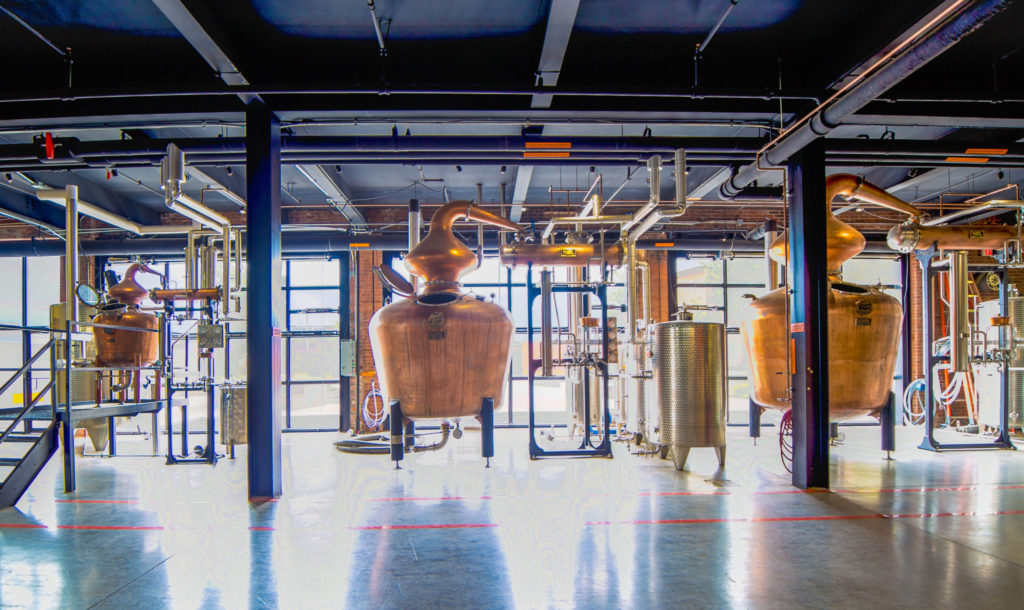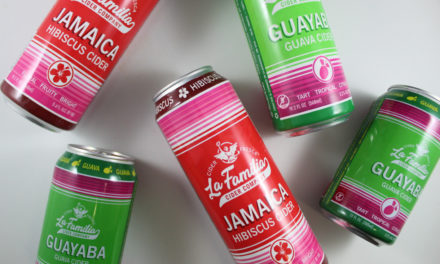For many drinks brands, the tasting room represents a fun opportunity to dabble in classic bar and restaurant design. After all, we’ve all experienced the proven pleasure of sipping a great martini at a zinc countertop or enjoying how the rich aroma of a mahogany leather sofa mingles with malbec.
While there’s nothing inherently wrong with sticking to familiar concepts, there’s something to be said for the element of surprise. Some producers have used their tasting room as an opportunity to explore the boundaries of architecture and design, creating remarkable environments that stick with visitors long after the tour has passed. We sat down with three producers who’ve turned their tasting rooms into innovative embodiments of their brands to learn how they did it, what they’ve learned, and the many ways their choices shape their guests’ experiences.
McPherson Cellars
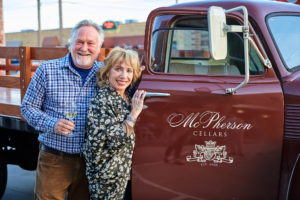
“I thought, ‘This building already has a lot of angular stuff going on, so we need to bring in some of that curving form.’” —Sylvia McPherson, McPherson Cellars [Photo courtesy McPherson Cellars]
“This was a former Coca-Cola bottling plant,” explains Sylvia McPherson, whose husband, winemaker Kim McPherson, owns the winery. While the exact details have been lost to the fog of time, the historic building was originally constructed sometime in the 1930s, and it served as a regional bottling plant for Coca-Cola until the 1950s before being converted into a variety of other industrial uses. Spanning an entire city block in downtown Lubbock, the building had grown in phases over the years, creating multiple distinct spaces within the larger footprint.
When the McPhersons bought the building in 2008, it had fallen into disrepair, but the architectural bones were still remarkable. “I would call it post-Art Deco/Moderne style,” says Sylvia McPherson. Boasting mid-century details like curved windows, long horizontal lines, and intricate exposed brickwork, the McPhersons saw past the restoration work to the true potential in the space.
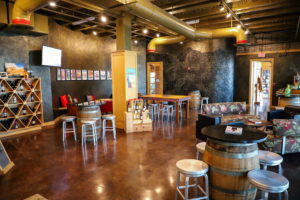
[Photo courtesy McPherson Cellars]
A 50-foot long, pill-shaped window in the tasting room, for instance, inspired the addition of many curved interior walls. “I thought, ‘This building already has a lot of angular stuff going on, so we need to bring in some of that curving form,’” says McPherson.
Three different types of exposed brick in the event space posed a challenge. Finding contemporary bricks to match all three patterns was impossible, so she developed a textured plaster treatment to mask two of the three surfaces while preserving her favorite of the bunch. Riffing on classic mid-century motifs, McPherson also designed a quilted pattern brick water feature that combined vintage brick with river rock for an organic, irregular look.
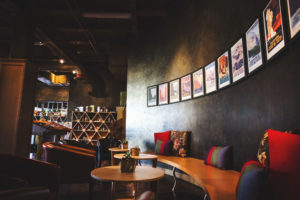
[Photo courtesy McPherson Cellars]
Turman says the repurposing of the old plant consistently fascinates visitors. “We have an entire section of the events center dedicated to the history of the building,” he says, “and it’s a big part of our tour. We love to show off that old buildings like this don’t have to be condemned; they can still have a lot of life in them if you’re willing to put in the work.”
In the grand scheme of things, 80 years isn’t so old. “By the standards of European wineries, this is all brand-new,” laughs McPherson.
Copper & Kings Distillery
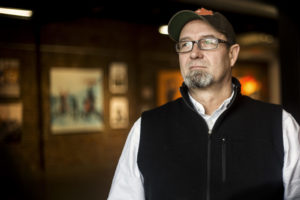
“Little brands need big personalities.” —Joe Heron, Copper & Kings Distillery [Photo courtesy Copper & Kings]
From a design perspective, that means industrial style, bold color, music and art throughout the building, and an emphasis on spaces that encourage visitors to gather and interact. “For us, having a very modern design was very deliberate to remove ourselves from the traditional bourbon archetype,” says Heron. “We see our American brandy as enjoying much more scope to be adventurous, innovative, and inventive.”
For help designing a space that reflected that ethos, Heron partnered with architect Ted Payne, principal at Louisville-based Payne Architecture. Payne says he understood right away the value in standing out: “It was obvious we had to do something that was contemporary and exciting.”
The distillery is located in a historic warehouse district on a property that once held two different buildings: a brick building built in the 1940s that was the former home of the Kentucky Seed Co., and a warehouse built in the early 1970s. The design team tore down the ‘70s warehouse, which was falling apart, but left the sturdy brick seed building to house the production floor, preserving a link to the property’s past and satisfying local historic district planners.
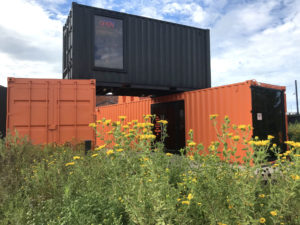
[Photo courtesy Copper & Kings]
Where the dilapidated warehouse had been, Payne Architecture designed an expansive public courtyard to host gatherings, parties, events, and concerts. “We needed a space where we could host our own events to illustrate the brand, from surf rock bands to The Rocky Horror Picture Show. We wanted to create a community asset, where people could come in and where our brand was a hero,” explains Heron.
While contemplating how to design the courtyard, Payne says he drew inspiration from an unlikely source: his kid’s Lego set. “I picked up three Legos in black and orange and started playing with them,” he laughs. “Next thing I know, we have three shipping containers sitting out front of the distillery.”
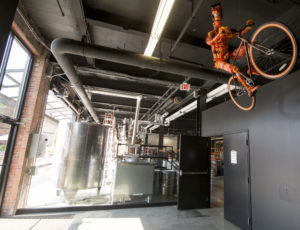 Those shipping containers now house Copper & King’s check-in counter, a catering kitchen, and bathroom amenities. Ted says they chose to repurpose shipping containers because of their modern industrial feel and a reflection of a positive environmental sustainability stance, not necessarily as a budget-stretching device—indeed, shipping containers are often more expensive to work with than many expect.
Those shipping containers now house Copper & King’s check-in counter, a catering kitchen, and bathroom amenities. Ted says they chose to repurpose shipping containers because of their modern industrial feel and a reflection of a positive environmental sustainability stance, not necessarily as a budget-stretching device—indeed, shipping containers are often more expensive to work with than many expect.
“People think containers are $500 each and they can design a house for $1,500,” says Payne. “It doesn’t work that way. Even brand-new containers leak. We basically ended up building a shell within a shell, which let us insulate and make them a comfortable and sophisticated guest experience.” Pop-out windows, lots of skylights, and warm wood interiors give the containers a jewel box-like feel and a lovely, intimate view of the butterfly garden.
Outside, some of the shipping containers are painted a vivid orange—one of Copper & King’s signature colors, chosen because it evokes the patina of a copper pot still, and for its warm, welcoming feel and clear identity. “Little brands need big personalities,” explains Heron. “They need to stand for very definitive things. And for us, we stand for creative expression and an adventurous libation.”
Lost Spirits
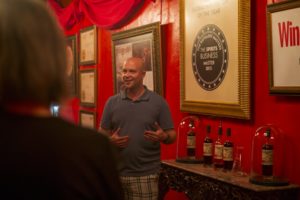
“There are rules when designing amusement park rides for kids. But this is for adults, so we intentionally break all those rules.” —Bryan Davis, Lost Spirits Distillery [Photo by Nic Coury, courtesy Lost Spirits]
At least, that’s what was happening when I visited. Founder Bryan Davis, who designed and built the tasting room—with (he’s quick to point out) the help of a world-class engineering team, including several PhD scientists, computer scientists, electrical engineers, and a well-known architect—says the space is constantly evolving, and a new iteration is in the works. “There’s never been a time it wasn’t under construction,” he laughs.
Lost Spirits is located in the Arts District in Los Angeles, Calif., a cluster of warehouses and creative businesses just south of downtown. It’s a hip area, but there are few clues from the exterior about what lies on the other side of the distillery’s ordinary brick façade. Yet the space’s superficial anonymity has proved no barrier to visitors; Davis says Lost Spirits sees between 3,000 and 5,000 visitors every month, many of whom have heard of the distillery through word of mouth and can’t wait to see it for themselves.
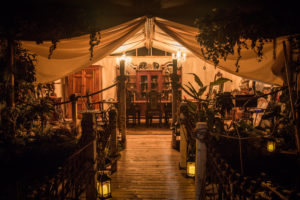
[Photo by Laurel Dailey, courtesy Lost Spirits]
“There are rules when designing amusement park rides for kids,” says Bryan. “You have to remind them that it’s fake every 20 to 30 seconds or so to make sure they feel safe. But this is for adults, so we intentionally break all those rules. It’s a level of immersion you can’t do in a typical amusement park ride.”
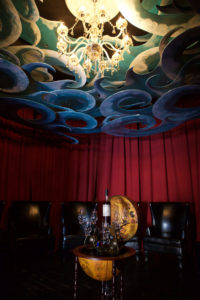
[Photo by Dario Griffin, courtesy Lost Spirits]
We look around. We got here by carousel, of course, but where that carousel is now is…not clear. There are no glaring red exit signs, no obvious clues, no sign at all that we’re anywhere but in the heart of the dark savannah night. “You don’t know. Seventy-five percent of people have no idea how they got here. That’s why it works,” he says, grinning impishly.
Then, the soundtrack begins to change. We can hear people’s voices in the distance, and they sound angry. “Locals,” he says with a wink. “It’s the LA Arts District, so most are vegan, but still, we should get out of here.” Davis gets up, strolls purposefully to a large wooden cabinet, and opens the door. “Quick, in here.” We brush through rows of hanging fur coats in the dark to emerge into the most important room at any distillery: the gift shop. Of course, Lost Spirits puts a different spin on it, but let’s just say the salesbirdship is top notch.



















